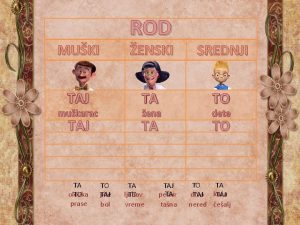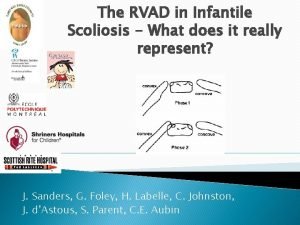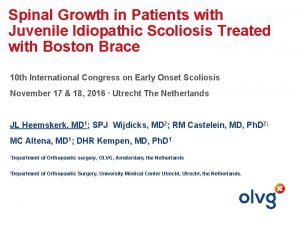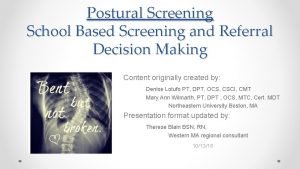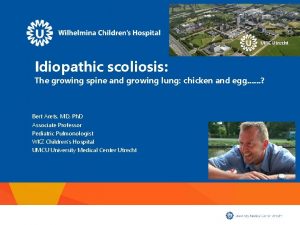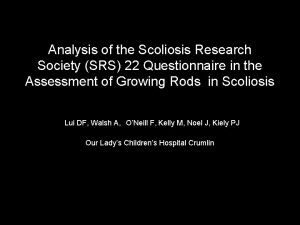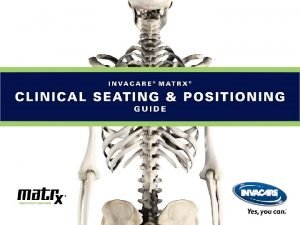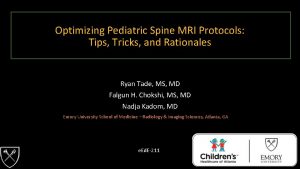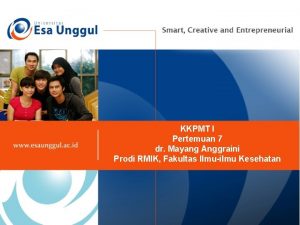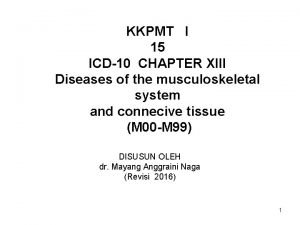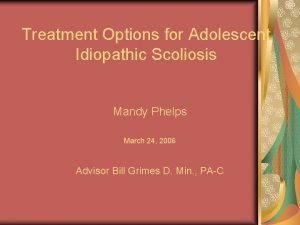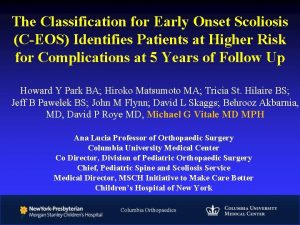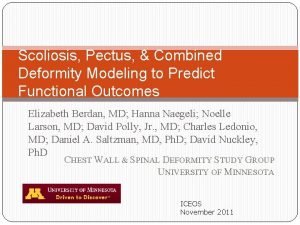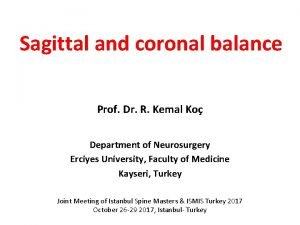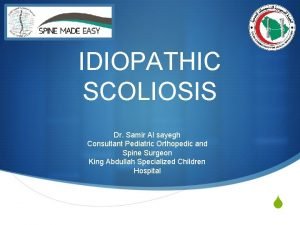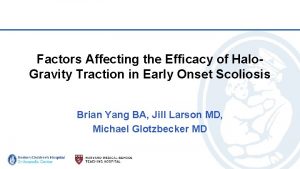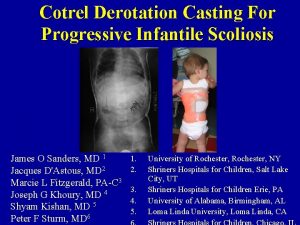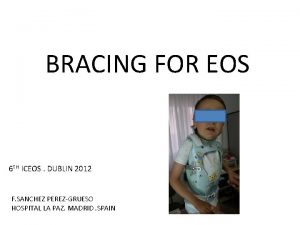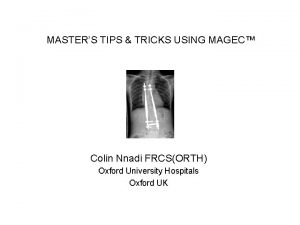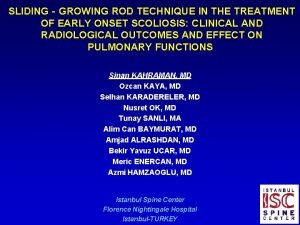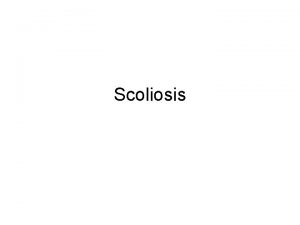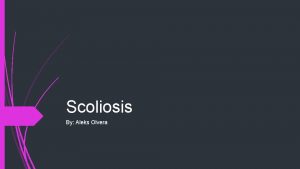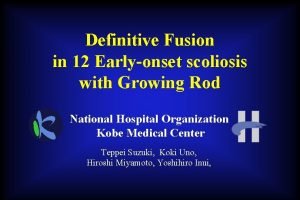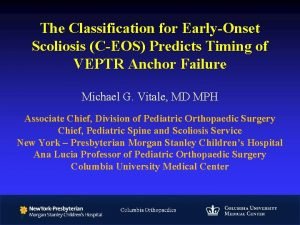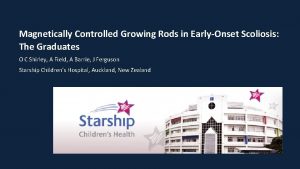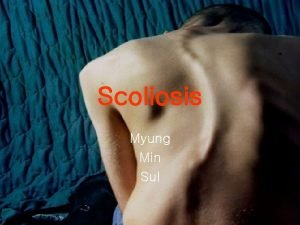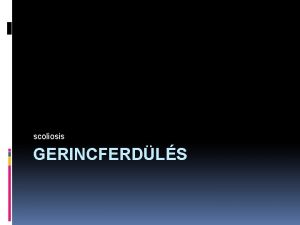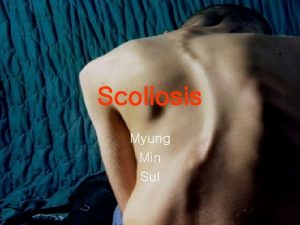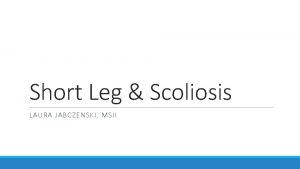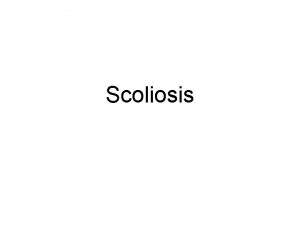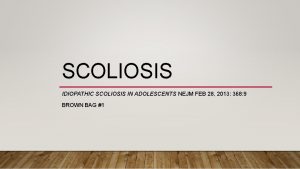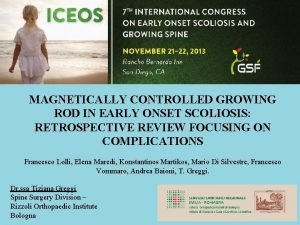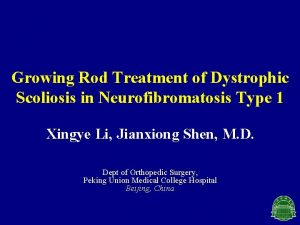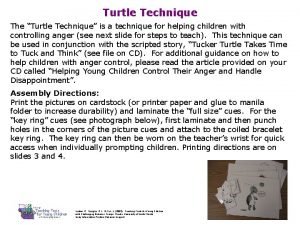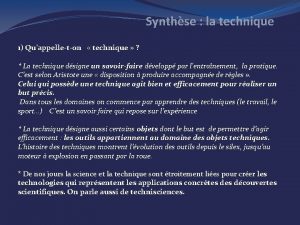SLIDINGGROWING ROD TECHNIQUE FOR MANAGEMENT OF EARLYONSET SCOLIOSIS




















- Slides: 20

SLIDING-GROWING ROD TECHNIQUE FOR MANAGEMENT OF EARLY-ONSET SCOLIOSIS Meric ENERCAN, MD Mutlu COBANOGLU, MD Sinan KAHRAMAN, MD Bahadır H. GOKCEN, MD Sinan YILAR, MD Erden ERTURER, MD Cagatay OZTURK, MD Azmi HAMZAOGLU, MD Istanbul Spine Center Florence Nightingale Hospital Istanbul-TURKEY

Paper # 3 SLIDING-GROWING ROD TECHNIQUE FOR MANAGEMENT OF EARLY-ONSET SCOLIOSIS Author Relationships Disclosed Meric ENERCAN Mutlu COBANOGLU Sinan KAHRAMAN Bahadır H. GOKCEN Sinan YILAR Erden ERTURER Cagatay OZTURK Azmi HAMZAOGLU No Relationship No Relationship Medtronic (b) Medtronic(b) 8 th International Congress on Early Onset Scoliosis and Growing Spine ICEOS (a) (b) (c) (d) (e) Grants/Research Support Consultant Stock/Shareholder Speakers’ Bureau Other Financial Support

BACKGROUND ü The main goal of treatment is to obtain and maintain curve correction while simultaneously preserving spinal, trunk, and lung growth. ü Growing rods have become increasingly popular in the treatment of early-onset scoliosis.

Problems with traditional growing rods systems 1997 1998 1999 2000 50º 68º 50º 56º 69º 40º 47º 44º 6 Y 7 Y 8 Y 9 Y ü Correction of the deformity will be achieved through only pure distractive forces between proximal and distal anchors. ü Because there are no apical and intermediate anchors along the main curve, it can not control rotational deformity, anterior spinal growth continues and deformity progresses.

Problems with traditional growing rods systems ü Curve control is especially difficult in kyphoscoliosis. ü Curve control is also difficult in sagittal plane. ü Requires repeated lengthening procedures. ü T 1 -S 1 length achieved after every lengthening procedure decreases with each subsequent lengthening and over time (Law of diminishing). ü Prolonged instrumentation and repeated lengthenings can result with autofusion.

PURPOSE Ø Using apical and intermediate anchors ü provide better correction and control of the main curve in both coronal and sagittal plane, ü prevent progression of deformity, ü decrease implant-related complications, ü decrease number of repeated lenghtenings, ü decrease rate of spontaneous fusion ü can be performed with regular instrumentation system, We tried to develop a dynamic fixation system instead of static fixation system.

Surgical Technique ü After skin-subcutaneous dissection, placement of polyaxial pedicle screws into the strategic vertebrae under flouroscopic guidance with muscle sparing technique. ü Recently robotic assistance is being used to decrease radiation exposure related to floroscopy. ü Depending on the size of the child, it can be performed with any cervical or pediatric instrumentation system.

Surgical Technique ü Use of skull (J-Tongue) – femoral traction application for the initial procedure provides more flexibility, decreases the need forceful correction maneuvers on immature spine and prevents possible implant failures.

fixed & fused loose fixed & fused ü Giving the proper contour to the rods and placement of proximal and distal rods. ü Deformity correction can be made with cantilever correction manevuer with double rods and domino connectors.

Surgical Technique fixed loose ü Domino connectors were placed generally at the lumbar region. ü Fixation of most proximal and most distal screws ü The rest of the screws have non-locked set-screws

MATERIAL & METHODS ü 11 (6 F/5 M) patients with early onset spinal deformities with a mean age of 5. 8 (3 -10) were evaluated. ü Preop, postop, f/up standing AP/L images with EOS were reviewed for radiological data. ü The results of patients treated with this technique for early onset spinal deformities with > 1 year follow-up was evaluated with respect to ; (1) curve correction; (2) spinal length achieved; (3) complications; (4) number of procedures performed with the new approach.

RESULTS ü The mean follow-up period was 14. 8 months (12 -19 months). ü Preop (MT) curve of 58. 7° (38°-89°) 24, 5° (5°-59°) ü Preop (TL/L) curve of 43, 4° (12°-88°) 16, 4° (3°-54°) ü Preop (TK) of 35, 1° (4°- 66°) 29, 4° (20°- 46°) ü Preop (LL) of 55, 3° (4°-89°) 55, 7° (31°-70°)

RESULTS ü The mean increase in length was 1. 14 mm (0. 7 -1. 41 mm) per month. ü The mean increase in T 1 -S 1 height was 1. 28 mm per month. ü The mean number of pedicles screws placed segments were 13, 6 (12 -16). ü No patient had neurological impairments. ü There was no rod breakages or other implant failure and wound problems treated without surgery. ü The most common postop radiological finding is dislodgement of non-locked set screws mainly at the apical region (in 3 patients). ü This modification prevented 22 repeated planned lengthening procedures.

SG, F, 6 Y 15° 42° 23° 17° 33° 3° 54° Ø Increase in length was 1. 12 mm per month. Ø T 1 -S 1 height was 1. 63 mm per month 54° 20, 84 mm 17, 70 mm 18, 32 mm 14, 07 mm Average 3, 1 mm in three months

SK, F, 9 Y 38° 23° 29° 63° 12° 69° 38° Ø Increase in length was 1. 03 mm per month. Ø T 1 -S 1 height was 1. 82 mm per month 70° 17, 23 mm 2, 52 mm 10, 23 mm 1, 12 mm Average 2, 45 mm in three months

SD, F, 10 Y 45° 29° 37° 38° 25° 12° 59° Ø Increase in length was 1. 31 mm per month. Ø T 1 -S 1 height was 1. 49 mm per month 62° 20, 62 mm 25, 13 mm 7, 13 mm 15, 08 mm Average 3, 9 mm in three months

SA, F, 9 Y 46° 32° 18° 32° 55° 108° 6° 56° 77° 69° Tr. UGA Ø Tr. UGA showed more than %70 flexibility. Ø This patient was treated with sliding –growing rod technique instead of apical vertebral resection.

CONCLUSION ü Our new treatment strategy provides that the screws in apical, intermediate and strategic vertebra controlled the curve, prevents progression, maintains rotational stability and allows continuation of trunk growth. ü Depending on the size of the child, it can be performed with any regular instrumentation system.

CONCLUSION ü Sliding-growing rod technique is a dynamic fixation technique which prevents multiple lengthening procedures. ü Short term results showed that sliding-growing rod technique works and allows spinal growth with low complication rate. ü Larger series and longer follow-up will provide more data about this system. ü Robotic assistance for pedicle fixation will decrease radiation exposure related to floroscopy.

THANK YOU!
 Muški ženski i srednji rod pitanja
Muški ženski i srednji rod pitanja Rvad
Rvad Scoliosis chiropractor seminole county
Scoliosis chiropractor seminole county Postural screening worksheet
Postural screening worksheet Scoliosis
Scoliosis Scoliosis research society
Scoliosis research society Hyperextesion
Hyperextesion Mri scoliosis protocol
Mri scoliosis protocol Disorder of synovium and tendon
Disorder of synovium and tendon Disorder of synovium and tendon
Disorder of synovium and tendon Infantile scoliosis casting
Infantile scoliosis casting Scoliosis advisor
Scoliosis advisor Early onset scoliosis classification
Early onset scoliosis classification Rib hump scoliosis
Rib hump scoliosis Coronal balance
Coronal balance Scoliosis advisor
Scoliosis advisor Factors affecting traction
Factors affecting traction Risser cast scoliosis
Risser cast scoliosis X iceos
X iceos Colin nnadi
Colin nnadi Kontinuitetshantering i praktiken
Kontinuitetshantering i praktiken
